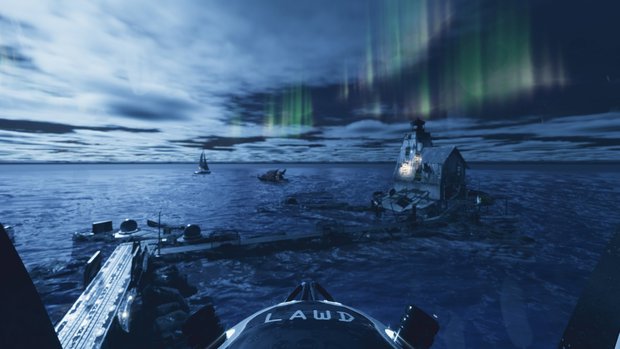The Curse of Grimsey Island review

- 1 Comment
The promise of a remote drone investigation off the Iceland coast is partly sunk by a storytelling disconnect
Gunshots in the night. A murder, committed within a solitary lighthouse on the edge of a dark, foreboding sea. Six persons of interest, all present in the area at the time. You are the investigator tasked with shedding light on this mystery, as well as a few others – if you can find them. But this isn’t your garden variety case; the year is 2075, and crime scenes are investigated in virtual space by specially trained operatives. Sounds like a recipe for a tasty, atmospheric adventure to puzzle through, an enjoyable evening spent curled up in front of the screen, discovering and pondering evidence. And it could have been – it certainly has all the makings to do so – but Miga Games’ 3D detective simulation The Curse of Grimsey Island falls short in its storytelling and failed to hook me. This was reflected in the failed final rating given to me for my best (yet wrong) guess, causing me to throw in the towel rather than doubling down and sifting through its content until I got it right.
The Curse of Grimsey Island has a simple yet intriguing concept, to be sure: plop the player into an open world and let them explore at their leisure, uncover clues (or fail to do so), hack suspects’ cellular phones and private messages, and ultimately attempt to identify who, why, and howdunit. There are even three ancillary cases that can be found and solved in the bargain. You’ll navigate the LAWD (Land, Air, and Water Drone) – essentially the first-person camera – around a Nanodeck, the aforementioned virtual crime scene area surrounding the lighthouse, and use it to interact with and scan various objects in the environment in a bid to put the puzzle pieces together. When you’re reasonably sure you’ve cracked the case(s), you can open your menu and fill in the culprit, motive, and weapon from a list of all possible options you’ve found to that point. Then fly your drone to the access point at the periphery of the game area and upload your findings – and if you get a grade higher than F, you’re a better sleuth than me!

On paper, I should love a game with this setup. But during the two to three hours it took me to fully explore the game space, I came to an unfortunate conclusion: it’s not enough for a game to have a neat premise; the mystery has to be compelling too. My primary problem with Grimsey Island is that its mystery simply never captivated me. I did everything mentioned above: explored and scanned every nook and cranny of the lighthouse, even dove under the waves to expand my search, flew to the farthest corners of the virtual map, broke into locked cell phones and played back snatches of recorded holographic dialogue between suspects. And when all was said and done, I still ended up being nonplussed about it all. Where was the through-line? Where was the connective tissue tying everything together? Where was the context for any of it – characters, events, clues, timelines – to make sense for me?
It’s really in this regard where things fall apart. Because you’re an observer from the outside looking in, because your discoveries are out of context and fragmented, and because the game’s open-world nature means you’re uncovering information wholly out of order, context is so very important for comprehension and, in turn, for drawing accurate and satisfying conclusions. This all-important context relies solely on the game’s writing, and when it failed to click, characters became faceless voids and the narrative buckled under its own flimsy architecture. I didn’t know what bits of conversation or information were important and what weren’t, but I soon stopped caring either way, as neither option made it any more intriguing. I found enough to make some educated guesses, and a few stabs in the dark, but predictably failed miserably. I did my best, but my best turned out to be insufficient. Oh well.
Of course, the story might gel better with some players than it did with me, which would make a big difference in Grimsey Island’s overall fun factor. The game’s cast of characters consists of members of two competing teams of professional treasure hunters, both searching the area for a fabled long-lost Viking artifact. Some might be more drawn into the death of Anna Adler, the leader of one of the rival groups. Others may enjoy diverting from the murder investigation to follow the groups’ search for the artifact – using their messages and recorded conversations – in a cutthroat race to be the first to find the treasure. And still others might be more enthralled by the age-old relics that rest within the sea itself. Unfortunately, I found the rivalries, the politics, and even the historical discoveries devoid of deeper meaning that would have connected me more to the story.
It’s a shame the narrative is so disappointing, because there is a well-done investigation engine hidden beneath the undercooked central mystery, which could have made for some tasty sleuthing. The drone has a handy feature that highlights objects of interest in the environment and is small and mobile enough that it can easily access tight spaces. I got into the lighthouse my first time by squeezing through the yellow police tape criss-crossing a busted-out upstairs window. It also has a handy feature that can instantly change the investigation area from day to night or vice versa, though this feature is rather wasted here; the day-night toggle is really only needed for a handful of conversations that are only accessible during certain times of day, while the vast majority are available day or night – and, really, since we’re in a digital reconstruction of past events, what in-game logic would explain the need for an occasional time change?
The drone responds to standard free-roaming keyboard-mouse controls, while interacting with the environment is done via mouse-click, at which point the drone extends a cable-like arm to connect to the object in question. It can detect microscopic fibers, fingerprints, or trace elements via a simple “scroll a magnified view of the object to find the hidden clue” mini-game, hack into cell phone apps via a slightly more involved “trace the pattern” mini-game, and even open certain objects or budge them aside. Once you’ve located a clue that you feel is vital, you can place an evidence marker beside it, officially tagging it as part of the solution (though this is not required to make them appear as possible solutions), which can improve a predictive outcome percentage if you’re lucky. There is even a small-scale environmental puzzle, not notable for its challenge but for its solitary inclusion in this world, which involves using the drone to physically manipulate an object in order to find a whole new area to explore. Looking back on it, I wish there were more interactions of this kind, but the framework for their inclusion is certainly in place.
The game also boasts some nice presentation values. While the voice work can’t be considered a highlight by any stretch, the ambient environmental sounds of a windswept section of Icelandic coast are great, as are the subdued underwater effects. Unobtrusive piano music and ethereal synth tracks work fine to accompany the exploration, but nothing particularly stands out for the relatively short amount of gameplay time. Character models excluded, the game does look nice, as the limited environments are detailed and visually impressive. The lighthouse museum is in bad repair but still holds many objects that were once prime exhibits, while diving underwater reveals fish and manta rays peacefully swimming by, and getting a bird’s eye view of the aurora borealis and the frothing waves crashing below is a memorable moment. If only stopping to smell the roses wasn’t preferable to continuing your journey, but before long it’s time to get back to sweeping the terrain for clues.
Final Verdict
The Curse of Grimsey Island has some good ideas, both in terms of the overall game experience and in the investigative tools at your disposal. However, when it comes to the narrative supporting the gameplay, I was left rather underwhelmed. The clues I unearthed while trying to piece the murder together revealed an unsatisfying enigma. Characters weren’t fleshed out nearly enough or presented in a way that would solidify them in my investigator brain, clues were sometimes so vague that I couldn’t separate actual evidence from red herrings, and the story I was slowly uncovering was so disjointed that it did not resonate with me at all. I can see the potential here, but without a better-written mystery to support it, I cannot fully get behind this one. Mileage will perhaps vary for some sci-fi sleuths out there, but at the end of my investigation, I was content to surrender my badge and file this one away in the Cold Case archive.
Hot take
The Curse of Grimsey Island brings some interesting ideas to the table but struggles to make the most of them, with a sci-fi murder mystery still sorely in need of refinement and better connection to the gameplay.
Pros
- Interesting open-world spin on a murder investigation
- Some useful tools at your disposal to become a drone pilot Sherlock Holmes
- Environments look and sound good
Cons
- Central mystery does not come together in a satisfying manner
- Questionably voiced characters lack depth and relatability
- Many clues are dreadfully vague or otherwise unhelpful
Pascal played The Curse of Grimsey Island on PC using a review code provided by the game's publisher.











1 Comment
Want to join the discussion? Leave a comment as guest, sign in or register.
Too bad. The premise sounds interesting indeed.
Reply
Leave a comment